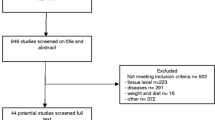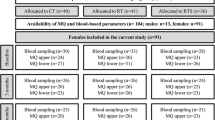Abstract
Aging-related loss of muscle function is a predictor of mortality and a surrogate parameter of the aging process. Its consequences include a high risk for falls, hip fractures, and loss of autonomy. Aging is associated with changes in the oxidant/antioxidant balance including a decrease in plasma thiol (cysteine) concentration. To assess the importance of cysteine, we determined in a double-blind study the effects of N-acetylcysteine on the functional capacity of frail geriatric patients and their response to physical exercise. The subjects on placebo showed only a relatively weak response, and 31% showed even a decrease in more than one parameter during the observation period. Low plasma arginine levels were correlated with a weak overall performance before exercise and a poor response to exercise. N-Acetylcysteine strongly enhanced the increase in knee extensor strength and significantly increased the sum of all strength parameters if adjusted for baseline arginine level as a confounding parameter. N-acetylcysteine had no significant effect on growth hormone and IGF-1 levels but caused a significant decrease in plasma TNF-α. These findings may provide a basis for therapeutic intervention and suggest that the loss of function involves limitations in cysteine and one or more other amino acids which may compromise muscular protein synthesis.




Similar content being viewed by others
Abbreviations
- IGF::
-
Insulin-like growth factor
- NAC::
-
N-Acetylcysteine
- TNF::
-
Tumor necrosis factor
References
Brody JA (1985) Prospects for an ageing population. Nature 315:463–466
Lamberts SWJ, van den Beld AW, van der Lely A-J (1997) The endocrinology of aging. Science 278:419–424
Campion EW (1994) The oldest old. N Engl J Med 330:1819–1820
Fiatarone MA, O'Neill EF, Ryan ND, Clements KM, Solares GR, Nelson ME, Roberts SB, Kehayias JJ, Lipsitz LA, Evans WJ (1994) Exercise training and nutritional supplementation for physical frailty in very elderly people. N Engl J Med 330:1769–1775
American Geriatrics Society, British Geriatrics Society and American Academy of Orthopaedic Surgeons Panel on Falls Prevention (2001) Guidelines for the prevention of falls in older persons. J Am Geriatr Soc 49:664–672
Rantanen T, Harris T, Leville SG, Visser M, Foley D, Masdaki K, Guarlnik JM (2000) Muscle strength and body mass index as long term predictors for mortality in initially healthy men. J Gerontol 55:M168–M173
Pennix B, Ferrucci L, Leveille S, Rantanen T, Pahor M, Guaralnik J (2000) Lower extremity performance in nondisabled older persons as a predictor of subsequent hospitalization. J Gerontol 55A:M691–M697
Guralnik JM, Ferrucci L, Simonsick EM, Salive ME, Wallace RB (1995) Lower extremity function in persons over the age of 70 years as a predictor of subsequent disability. N Engl J Med 232:556–561
Guralnik JM, Simonsick EM, Ferucci L, Glynn RJ, Berkman LF, Blazer DG, Scherr PA, Wallace RB (1994) A short physical performance battery assessing lower extremity function: association with self-reported disability and prediction of mortality and nursing home admission. J Gerontol 49:M85–M94
O'Loughlin JL, Robitaille Y, Boivin J-F, Suissa S (1993) Incidence of and risk for falls and injurious falls among the community-dwelling elderly. Am J Epidemiol 137:342–354
Tinetti ME, Baker DJ, McAvay G, Claus EB, Garrett P, Gottschalk M, Koch ML, Trainor K, Horwitz RI (1994) A multifactorial intervention to reduce the risk of falling among elderly people in the community. N Engl J Med 331:821–827
Chandler JM, Hadley EC (1996) Exercise to improve physiologic and functional performance in old age. Clin Geriatr Med 12:761–784
Hauer K, Rost B, Rütschle K, Opitz H, Specht N, Bärtsch P, Oster P, Schlierf G (2001) Exercise training for rehabilitation and secondary prevention of falls in geriatric patients with a history of injurious falls. J Am Geriatr Soc 49:10–20
Buchner DM, Cress ME, DeLateur BJ, Esselman PC, Margherita AJ, Price R, Wagner EH (1997) The effect of strength and endurance on gait, balance, fall risk, and health services use in community-living older adults. J Gerontol A Biol Sci Med Sci 52A:M218–M224
Harman D (1956) Aging: a theory based on free radical and radiation chemistry. J Gerontol 11:298–300
Ames BN, Shigenaga MK, Hagen TM (1993) Oxidants, antioxidants, and the degenerative diseases of aging. Proc Natl Acad Sci USA 90:7915–7922
Liu J, Head E, Gharib AM, Yuan W, Ingersoll RT, Hagen TM, Cotman CW, Ames BN (2002) Memory loss in old rats is associated with brain mitochondrial decay and RNA/DNA oxidation: partial reversal by feeding acetyl-L-carnitine and/or R-α-lipoic acid. Proc Natl Acad Sci USA 99:2356–2361
Hagen TM, Liu J, Lykkesfeldt J, Wehr CM, Ingersoll RT, Vinarsky V, Bartholomew JC, Ames BN (2002) Feeding acetyl-L-carnitine and lipoic acid to old rats significantly improves metabolic function while decreasing oxidative stress. Proc Natl Acad Sci USA 99:1870–1875
Dröge W (2002) Free Radicals in the physiological control of cell function. Physiol Rev 82:47–95
Hack V, Breitkreutz R, Kinscherf R, Röhrer H, Bärtsch P, Taut F, Benner A, Dröge W (1998) The redox state as a correlate of senescence and wasting and as a target for therapeutic intervention. Blood 92:59–67
Samiec PS, Drews-Botsch C, Flagg EW, Kurtz JC, Sternberg Jr P, Reed RL, Jones DP (1998) Glutathione in human plasma: decline in association with aging, age-related macular degeneration, and diabetes. Free Radic Biol Med 24:699–704
Sohal RS, Weindruch R (1996) Oxidative stress, caloric restriction, and aging. Science 273:59–63
Dröge W (2002) The plasma redox state and ageing. Ageing Res Rev 1:257–278
Dröge W (2002) Aging-related changes in the thiol/disulfide redox state: implications for the use of thiol antioxidants. Exp Gerontol (in press)
Ushmorov A, Hack V, Dröge W (1999) Differential reconstitution of mitochondrial respiratory chain activity and plasma redox state by cysteine and ornithine in a model of cancer cachexia. Cancer Res 59:3527–3534
Breitkreutz R, Pittak N, Nebe CT, Schuster D, Brust J, Beichert M, Hack V, Daniel V, Edler L, Dröge W (2000) Improvement of immune functions in HIV infection by sulfur supplementation. Two randomized trials. J Mol Med 78:55–62
Hildebrandt W, Alexander S, Bärtsch P, Dröge W (2002) Effect of N-acetylcysteine on the hypoxic ventilatory response and erythropoietin productoin: linkage between plasma thiol redox state and O2-chemosensitivity. Blood 99:1552–1555
Adair JC, Knoefel JE, Morgan N (2001) Controlled trial of N-acetylcysteine for patients with probable Alzheimer's disease. Neurology 57:1515–1517
Paolisso G, Rizzo MR, Mazziotti G, Tagliamonte MRGA, Rotondi M, Carella C, Giugliano D, Varricchio M, D'Onofrio F (1998) Advancing age and insulin resistance: role of plasma tumor necrosis factor-α. Am J Physiol 275:E294–E299
Greiwe JS, Cheng B, Rubin DC, Yarasheski KE, Semenkovich CF (2001) Resistance exercise decreases skeletal muscle tumor necrosis factor-α in frail elderly humans. FASEB J 15:475–482
Salomon F, Cuneo RC, Hesp R, Sonksen PH (1998) The effect of treatment with recombinant human growth hormone on body composition and metabolism in adults with growth hormone deficiency. N Engl J Med 321:1797–1803
Barton-Davis ER, Shoturma DI, Musaro A, Rosenthal N, Sweeney HL (1998) Viral mediated expression of insulin-like growth factor I blocks the aging-related loss of skeletal muscle function. Proc Natl Acad Sci USA 95:15603–15607
American College of Sports Medicine (1995) ACM's guidelines for exercise testing and prescription, 5th edn. Williams & Wilkins, Baltimore
Oswald WD, Fleischmann UM (1995) Nürnberger Alters-Inventar (NAI), 3rd edn. Hogrefe, Göttingen
Dröge W, Roth S, Altmann A, Mihm S (1987) Regulation of T cell functions by L-lactate. Cell Immunol 108:405–416
Rutherford OM, Jones DA (1986) The role of learning and coordination in strength training. Eur J Appl Physiol 55:100–105
Esmarck B, Andersen JL, Olsen S, Richter EA, Mizuno M, Kjǽr M (2001) Timing of postexercise protein intake is important for muscle hypertrophy with resistance training in elderly humans. J Physiol (Lond) 535.1:301–311
Yarasheski KE, Zachwieja JJ, Bier DM (1993) Acute effects of resistance exercise on muscle protein synthesis rate in young and elderly men and women. Am J Physiol 265:E210–E214
Welle S, Thornton C, Statt M, McHenry B (1994) Postprandial myofibrillar and whole body protein synthesis in young and old human subjects. Am J Physiol 267:E599–E604
Balagopal P, Rooyackers OE, Adey DB (1997) Effects of aging on in vivo synthesis of skeletal muscle myosin heavy-chain and sarcoplasmic protein in humans. Am J Physiol 273:E790–E800
Garcia-Martinez C, Lopez-Soriano FJ, Argiles JM (1993) Acute treatment with tumour necrosis factor-α induces changes in protein metabolismin rat skeletal muscle. Mol Cell Biochem 125:11–18
Frost RA, Lang CH, Gelato MC (1997) Transient exposure of human myoblasts to tumor necrosis factor-α inhibits serum and insulin-like growth factor-1 stimulated protein synthesis. Endocrinology 138:4153–4159
Goodman MN (1991) Tumor necrosis factor induces skeletal muscle protein breakdown in rats. Am J Physiol 260:E727–E730
Hotamisligil GS, Peraldi P, Budavari A, Ellis R, White MF, Spiegelman BM (1996) IRS-1-mediated inhibition of insulin receptor tyrosine kinase activity in TNF-α- and obesity-induced insulin resistance. Science 271:665–668
Bruunsgaard H, Andersen-Ranberg K, Jeune B, Pedersen AN, Skinhoj PKPB (1999) A high plasma concentration of TNF-α is associated with dementia in centenarians. J Gerontol 54A:M357–M364
Jones DP, Carlson JL, Mody Jr VC, Cai J, Lynn MJ, Sternberg Jr P (2000) Redox state of glutathione in human plasma. Free Radic Biol Med 28:625–635
Hara K, Yonezawa K, Weng Q-P, Kozlowski MT, Belham C, Avruch J (1998) Amino acid sufficiency and mTOR regulate p70 S6 kinase and eIF-4E BP1 through a common effector mechanism. J Biol Chem 273:14484–14494
Wang X, Campbell LE, Miller CM, Proud CG (1998) Amino acid availability regulates p70 S6 kinase and multiple translation factors. Biochem J 334:261–267
Bodine SC, Stitt TN, Gonzalez M, Kline WO, Stover GL, Bauerlein R, Zlotchenko E, Scrimgeourt A, Lawrence JC, Glass DJ, Yancopoulos GD (2001) Akt/mTOR pathway is a crucial regulator of skeletal muscle hypertrophy and can prevent muscle atrophy in vivo. Nat Cell Biol 3:1014–1019
Fukagawa NK, Minaker KL, Young VR, Matthews DE, Bier DM, Rowe JW (1989) Leucine metabolism in aging humans: effect of insulin and substrate availability. Am J Physiol 256:E288–E294
Biolo G, Fleming RYD, Maggi SP, Wolfe RR (1995) Transmembrane transport and intracellular kinetics of amino acids in human skeletal muscle. Am J Physiol 268:E75–E84
Volpi E, Ferrando AA, Yeckel CW, Tipton KD, Wolfe RR (1998) Exogenous amino acids stimulate net muscle protein synthesis in the elderly. J Clin Invest 101:2000–2007
Flakoll PJ, Kulaylat M, Frexes-Steed M, Hourani H, Brown LL, Hill JO, Abumrad NN (1989) Amino acids augment insulin's suppression of whole body proteolysis. Am J Physiol 257:E839–E847
Biolo G, Fleming RYD, Wolfe RR (1995) Physiologic hyperinsulinemia stimulates protein synthesis and enhances transport of selected amino acids in human skeletal muscle. J Clin Invest 95:811–819
Sato H, Tamba M, Ishii T, Bannai S (1999) Cloning and expression of a plasma membrane cystine/glutamate exchange transporter composed of two distinct proteins. J Biol Chem 274:11455–11458
Miquel J (2002) Can antioxidant diet supplementation protect against age-related mitochondrial damage? Ann NY Acad Sci 959:508–516
Ikemoto M, Nikawa T, Kano M, Hirasaka K, Kitano T, Watanabe C, Tanaka R, Yamamoto T, Kamada M, Kishi K (2002) Cysteine supplementation prevents unweighting-induced ubiquitination in association with redox regulation in rat skeletal muscle. Biol Chem 383:715–721
Packer L, Roy S, Sen CK (1997) α-Lipoic acid: a metabolic antioxidant and potential redox modulator of transcription. Adv Pharmacol 38:79–101
Stoll S, Hartmann H, Cohen SA, Muller WE (1993) The potent free radical scavenger α-lipoic acid improves memory in aged mice: putative relationship to NMDA receptor deficits. Pharmacol Biochem Behav 46:799–805
Grune T, Reinheckel T, Davies KJA (1997) Degradation of oxidized proteins in mamalian cells. FASEB J 11:526–534
Gomes-Marcondes MC, Tisdale MJ (2002) Induction of protein catabolism and the ubiquitin-proteasome pathway by mild oxidative stress. Cancer Lett 180:69–74
Acknowledgements
The expert technical assistance of Mrs. U. Winter and Mr. H. Lips, and the assistance of Mrs. I. Fryson in the preparation of this manuscript are gratefully acknowledged.
Author information
Authors and Affiliations
Corresponding author
Rights and permissions
About this article
Cite this article
Hauer, K., Hildebrandt, W., Sehl, Y. et al. Improvement in muscular performance and decrease in tumor necrosis factor level in old age after antioxidant treatment. J Mol Med 81, 118–125 (2003). https://doi.org/10.1007/s00109-002-0406-7
Received:
Accepted:
Published:
Issue Date:
DOI: https://doi.org/10.1007/s00109-002-0406-7




